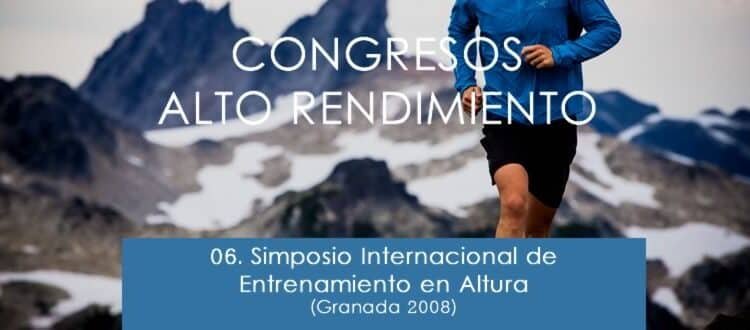Hypoxic stimulation in long distance runners. A necessity in high perfomance sport
In high level sport, the continual exposure to altitude is one of the contents of training which is normally used by long distance runners to increase their performance. This circumstance, found more and more in high performance sport, was helped in its initiation by intuition in training, currently science is widening its scope more and more with numerous related studies concerning the benefits and applications of adaptation and acclimatization in hypoxic environments, studies that are progressively breaking down the enigmas associated with the adapting to high altitudes corroborating the variability of responses amongst sportsmen/women subjected to more or less demanding altitude (1). In my specific sport, athletics, nobody can escape the evidence that the best specialists and world record holders like the Kenyans, Ethiopians, Mexicans and the Afro-Europeans, as also many of the best Spaniards that have been nominated in these specialities, are sportsmen/women who have lived and trained at high altitudes frequently and repeatedly. Hicham el Guerrouj, the best middle distance runner of all time, spent long periods of training at over 2000 meters above sea-level in Ifrane (Morroco). High performance sports trainers have been seeing, for a long time, that altitude training is one of the ethical instruments for increasing the benefits of their athletes, but the lack of formation of the technicians concerning high altitude adaptation, has not always produced results. There are various reasons that can justify this fact:
* The advances in genetics have made it evident that the inherited burden of previous generations seems to determine the capacity of positive adaptation. There are more than two dozen “target“ genes discovered in relation to hypoxia activated by the HIFI, which accumulate in conditions of hypoxia, this was discovered in 1992 by Semenza and Wang (2). The genetic load and its contribution to hypoxia adaptation have posed a turning point on the future contribution of this branch of science in the sports world.
* The non-existence of personalization with respect to the doses of altitude which should provoke positive adaptations is a constant feature of altitude training. The concepts of intensity referring to the level of hypoxia or the aforementioned altitude, and the volume of hypoxia exposure time or cycles of exposure should be individualized according to the many factors previous to the exposure.
* The scant continual exposure to altitude, due to the lack of knowledge concerning the effects of prolonged altitudinal stays, just as also the difficulty of putting this concept into practice for economical reasons and the time factor, have allowed the benefits to be rather unclear and undefined with respect to altitude training. The XXI century is furnishing us with the clarification of many doubts planted by the scientific world, regarding the true power of altitude in sport performance. Perhaps it is also forgotten that sportsmen/women of high level need a solid foundation of health which guarantees their future potential. In altitude we find a valuable instrument to assure the necessary health and quality of life which a high performance athlete needs and which the hypoxic environment contributes to the necessities of these athletes. Furthermore, lately new technologies have been added which have amplified enormously this area of training. Intermittent hypoxic training, having originated in Russia and having been well developed in Melbourne (Australia), has been enriched by those involved in this field, and some of the concepts I, personally, believe to be of prime importance for increased understanding of this stimulus:
* There is an urgent need to control the partial saturation of O2 as a reflection of internal response of the athlete in relation to the altitude, obtaining from it an adequate control of the hypoxic load. The recent appearance of load indexes (3) which help us to know the intensity and hypoxic volume of our sportsmen/women will be fundamental tools of quantification of the stimulus for a correct control of altitude training.
* A correct integration of the hypoxia together with regular physical training of the athlete, until recently inexistent in this field is needed. This detail permits the opening of the possibility of searching urgently for an integrated model in the relationship between training and hypoxia which is so necessary for obtaining an improvement in sport performance.
* With the new possibility of applying repeated intense and short cycles of hypoxic breathing, followed by cycles of normoxia (4), the organism can provoke important adaptations which in the long run will improve the health and the performance of the high level athlete, overcoming, at last, the difficulty of chronic exposure set out previously.
* To go beyond deeply rooted scientific aspects which only focus on the benefits of hypoxia in the stimulation of the EPO, creating an exclusive deformed concept that the gluco-proteic hormone is the only target factor stimulated by altitude.
The practical experience that I will present at this important Simposium to which I have been so generously invited, will be to show the real and useful model of the integration of hypoxia and training applied to my specialized athletes of high level resistance, depicting some models in the planning of altitude where I combine intermittent hypoxia with natural stays of altitude, basing my ideas on the principles which I set forth earlier.
References
(1) Individual variation in response to altitude training. Robert F. Chapman, James Stray- Gundersen, and Benjamin D. Levine. J Appl Physiol 85: 1448-1456.
(2) A Nuclear Factor Induced by Hypoxia via De Novo Protein Synthesis Binds to the Human Erythropoietin Gene Enhancer at a Site Required for Transcriptional Activation. Gregg L. Semenza and Guang L. Wang. Center for Medical Genetics, Maryland 21205 Received 17 July 1992/Returned for modification 25 August 1992/Accepted 2 September 1992.
(3) News appearing in the web www.programma-oxygeno.com (studies).
(4) Serum erythropoietin levels in healthy humans after a short period of normobaric and hyperbaric oxygen breathing: the “normobaric oxygen paradox”. Costantino Balestra, Peter Germonpré, Jacques R. Poortmans and Alessandro Marroni. J Appl Physiol 100: 512-518, 2006.






